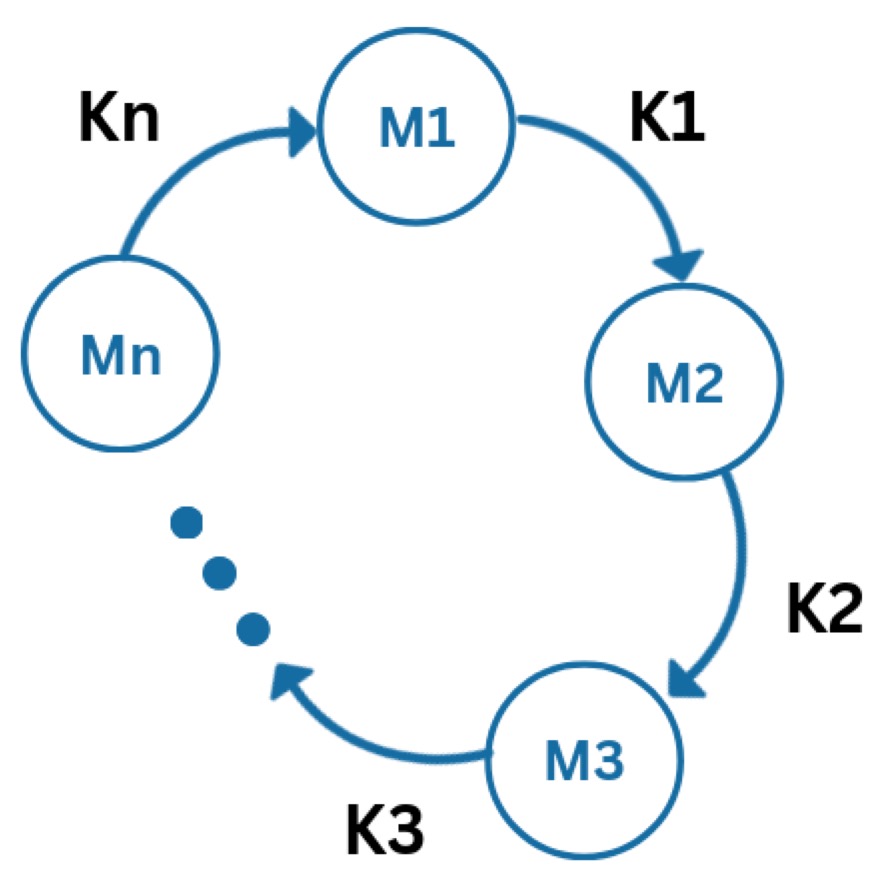So far, we have discussed:
- How to map your ecosystem’s network
- How to craft and deliver a compelling vision, and
- How to navigate the funding landscape for early-stage startups
We often underestimate the role of support networks on the path towards success. Stakeholders aren’t just passive observers, they are the lifeblood of your project. They bring valuable connections, critical resources, specialised services, and sometimes even direct funding.
I have seen firsthand how crucial these relationships can be when facing a wicked challenge.
In this lesson, we’ll explore how to strategically build, maintain, and leverage a stakeholder network to break through barriers and accelerate progress.
Game Theory and Resilient Strategies
Game theory offers a fascinating strategy known as a hypercycle, commonly known as a positive feedback loop.
Here’s how it works:
- If Player One (M1) wins, it boosts the chances of Player Two (M2) winning the next round.
- M2’s win increases M3’s chances, and so on.
- Eventually, the last player (Mn) supports M1, closing the loop.
This strategy creates a stable equilibrium where resources are distributed in a way that sustains the system. Remarkably, the equilibrium is resilient: if one player loses part of their resources, the loop naturally rebalances, with no external correction required.
This concept has been used to explain the stability of DNA replication.
The key insight?
Well-designed, interdependent systems can self-correct, redistribute risk, and maintain momentum under stress.
Building Hypercyclic Stakeholder Relationships
Before engaging potential stakeholders, consider their role within the broader ecosystem:
- What unique resources do they offer?
- Which other stakeholders could benefit from their involvement?
- Who could they help unlock or empower?
When each stakeholder supports and enables others, you create a self-sustaining network. Your role then shifts from ‘manager’ to facilitator, fostering collaboration rather than micromanaging contributions.
Timing is Everything: When to Approach Stakeholders
Equally important is when to approach each stakeholder.
After mapping your ideal support network, you’ll likely identify a ‘Big Fish’, a stakeholder whose involvement could transform the project. In our case, it was the Properties Office, whose approval would unlock the largest pool of funding.
The mistake would have been to approach them first.
Not because they might say no, but because they might say yes.
Big Fish come with big leverage. Once involved, they may reshape the project. Inserting gatekeepers, redefining priorities, or even displacing you from leadership. Involving them too early risks turning your project into theirs.
Instead, focus on building momentum first by securing smaller, more aligned stakeholders. Here is what that looked like in my project:
- First, I approached the Chaplaincy, which offered space and administrative support
- This enabled Student Services to run initiatives that attracted students to the Garden, fostering a shared culture
- The Imperial College Union formalised this growing momentrum
- Educational bodies like I-Explore, Imperial After:Hours, and other departments integrated their curricula into the green space
- Organic recruitment of educational talent led to research and innovation published by the Enterprise Lab and Center for Environmental Policy
- This academic network caught the attention of organisations like the V&A and RHS, eager to expand their Higher Education Networks
- Finally, the Properties Office joined. Not as an isolated stakeholder, but as part of a thriving, interdepartmental project, proud to fund and support a grass-roots initiative.
Each new stakeholder added inertia, building a network too significant to ignore. By the time the Properties Office entered, they weren’t reshaping the project, they were edorsing its success.
A Story on Leveraging Your Network: The Blocked Road and the Pressure Gauge
Entrepreneurs are often taught that hustle and grit can solve anything. But eventually, you’re likely to face a challenge rooted not in lack of effort, but in bureaucracy, politics, or opaque systems.
In those moments, indepenedent action often fails. What matters is influence, which comes from your network.
After securing £39,000 from the President’s Community Fund, the next step was submitting a Project Introduction Document with the Chaplaincy’s building manager. This document needed approval from Estates before we could receive a financial code to access the funds.
We worked through Christmas to get it done and submitted it in January.
Then … silence.
Two weeks passed.
Estates was normally responsive.
Eventually, the Building Manager’s supervisor followed up, only to discover the document had been blocked by a single committee member, for reasons that remain confidential.
No money meant no progress.
My direct inquiry attempt failed.
Communication broke down.
A year of work, and a successful grant, were at risk because of one person.
Step 1: Start from the Bottom
Instead of escalating immediately, I turned to the network.
- The Building Manager and his supervisor flagged the issue internally.
- Andrew, the Chaplain and co-creator of the Garden, provided detailed context.
- Department heads contributed to a joint message of support.
Still, no response.
Step 2: Move from the Sides
Next, I approached colleagues of the blocker – individuals indirectly involved with the project with whom I had worked before. I asked them to raise the project informally in meetings and via email, applying subtle peer pressure.
The Imperial College Union then drafted a petition aligning the Garden with student satisfaction KPIs, a powerful internal metric.
Still, silence.
Step 3: Apply Pressure from Above
Finally, I was introduced to the blocker’s direct superior. I outlined the project’s scope, its impact, and the depth of institutional support behind it.
By this point, I had been Bcc’d on over 15 emails from subordinates, colleagues, union representatives, academics, and the Chaplain – all echoing the same question: What’s happening with the Garden?
Within 24 hours, we received a full response and a timeline. A week later, the Project Introduction Document was approved.
Key Takeaway
Stakeholders are a double-edge sword. The more people with skin in the game, the more priorities you must juggle – and the easier it is for your project to drift from its original vision.
But approached strategically and managed carefully, a stakeholder network becomes an army of allies, big and small, who believe in your mission. And when challenges arise that exceed your own ability to conquer, that network becomes the difference between stagnation and success.
Stakeholder relationships are just one of the many support structure that founders can leverage to turn ideas into reality. Teams are another – but the nuances of team culture and recruitment are often overlooked, leading to internal friction or collapse.
In the next article, we will explore what to look for when choosing the right founding team.
Emilio Garcia Padron is an MSc Applied Mathematics student at Imperial College London, specializing in Computational Dynamical Systems. He is a full-stack software developer and founder of NEA Studios. He is also a founder of RE:GEN @ Imperial, a project aiming to protect and expand Green Spaces on Imperial grounds that raised over £39,000 in funding.
Image: DALL-E
🔴 Found these ideas useful?
Sharpen your edge

